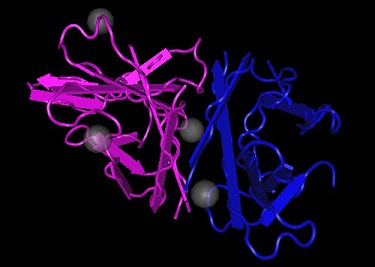SARS-CoV-2 Sublineages Lacking ORF8 Protein Do Not Replicate In Upper Respiratory Tract, Reducing Transmission But Increasing Inflammation!
COVID-19 News - ORF8 Protein May 26, 2023 2 years, 7 months, 1 week, 5 days, 22 hours, 38 minutes ago
COVID-19 News: In a groundbreaking study conducted at New York University Grossman School of Medicine, researchers have made a significant breakthrough in understanding the transmission dynamics of SARS-CoV-2, the virus responsible for the COVID-19 pandemic. The study, which focused on neonatal mice as a model for transmission, has revealed the crucial role of the SARS-CoV-2 ORF8 protein in reducing viral shedding and transmission.
 Structure Of The SARS-CoV-2 ORF8 Encoded Accessory Protein
Structure Of The SARS-CoV-2 ORF8 Encoded Accessory Protein
Since the emergence of SARS-CoV-2, scientists have been tirelessly working to unravel the mysteries surrounding its transmission. While previous studies primarily employed animal models such as golden hamsters or ferrets, the researchers at New York University opted to use neonatal mice. These mice offer several advantages, including lower cost, wider availability, and a versatile genetic toolbox.
One of the major challenges in studying SARS-CoV-2 transmission is the lack of efficient transmission observed in adult mice. However, the neonatal mouse model proved to be a game-changer, allowing for the transmission of clinical SARS-CoV-2 isolates.
The study team characterized the tropism, respiratory tract replication, and transmission of various SARS-CoV-2 variants, including the widely known Alpha, Beta, Gamma, Delta, and Omicron variants.
The study also focused on two specific accessory proteins of SARS-CoV-2, namely ORF6 and ORF8, which have been implicated in immune interference and counteracting host defense mechanisms.
By infecting the neonatal mice with recombinant SARS-CoV-2 strains lacking either ORF6 or ORF8, the researchers were able to determine the impact of these proteins on viral replication and transmission.
Surprisingly, the study findings unveiled a critical role for the ORF8 protein in reducing upper respiratory tract (URT) replication of SARS-CoV-2. The removal of ORF8 led to a shift in viral replication toward the lower respiratory tract, resulting in significantly delayed and reduced transmission in the neonatal mouse model.
This groundbreaking finding highlights the importance of accessory proteins in the transmission dynamics of SARS-CoV-2.
It was however noted based on findings from a previous study that SARS-CoV-2 sub-lineages lacking ORF8 displayed increased lung pathology scores, which may suggest an increased inflammatory process is induced by such sub-lineages.
https://pubmed.ncbi.nlm.nih.gov/36040867/
The accessory protein ORF8 of SARS-CoV-2 is a subject of great mystery, as it only shares 20% protein identity with its counterpart in SARS-CoV-1.
In SARS-CoV-2, ORF8 is a glycoprotein that is secreted, and it is believed to have diverse immunomodulatory functions.
Some proposed functions as proposed in previous studies and
COVID-19 News reports include mimicking IL-17A, interfering with the interferon type I pathway, mimicking histones, and downregulating MHC cl
ass I.
https://www.thailandmedical.news/news/covid-19-news-yale-study-shows-that-omicron-subvariants-are-evolving-further-through-mutations-on-orf8-proteins-to-escape-from-mhc-i-recognition
https://www.thailandmedical.news/news/covid-19-news-study-discovers-that-sars-cov-2-orf8-protein-exhibits-complement-inhibitory-properties-and-damages-innate-immunity
https://www.thailandmedical.news/news/university-of-pennsylvania-study-finds-that-sars-cov-2-uses-histone-mimicry-to-disrupt-host-epigenetic-regulation-for-disarming-host-immune-responses
https://www.thailandmedical.news/news/breaking-covid-19-news-french-scientists-uncover-how-sars-cov-2-orf8-protein-causes-dysregulation-of-gene-expression-in-infected-cells
https://www.thailandmedical.news/news/mayo-clinic-researchers-discover-that-sars-cov-2-orf8-protein-is-the-key-factor-that-is-causing-covid-19-disease-severity
https://www.thailandmedical.news/news/covid-19-research-university-of-california-scientist-identify-rapidly-evolving-immune-evasion-protein-sars-cov-2-orf8-
https://www.thailandmedical.news/news/study-finds-orf8-protein-of-sars-cov-2-induces-endoplasmic-reticulum-stress-like-responses-and-facilitates-virus-replication-by-triggering-calnexin
https://www.thailandmedical.news/news/covid-19-research-briefs-anti-androgens-and-covid-19,-possible-cytotoxic-t-cell-therapy-for-covid-19,-immune-evasion-by-evolving-orf8-protein-in-sars-
However, the full range of ORF8's functions and mechanisms of action are still not fully understood.
In the current study, it was found that deleting ORF8 led to reduced replication specifically in the upper respiratory tract (URT).
Surprisingly, despite a 100-fold lower virus presence in that area, the magnitude of inflammatory cytokines observed for the ORF8-deleted virus in the URT was similar to that of the original virus or a virus lacking ORF6.
This increased inflammation in the URT was consistent with previous observations in adult K18-hACE mice. It is possible that without ORF8, SARS-CoV-2 fails to suppress critical antiviral responses in the URT.
The study team proposed that the reduced replication in the URT and subsequent decrease in viral shedding are the reasons for the delayed and reduced transmission of the ORF8-deleted virus in mice. However, it is important to note that the overall replication efficiency of these ORF8-deleted viruses in tissue culture and the lungs of both neonatal and adult K18-hACE2 mice was unaffected.
To date, this is the first report of a compartment-specific role of a SARS-CoV-2 accessory protein in mice. The underlying mechanisms for ORF8's URT-specific role remain unknown. It is possible that the antiviral inflammatory processes triggered by SARS-CoV-2 infection differ in the URT compared to the lower respiratory tract (LRT). Factors such as the cellular environment and temperature differences between the URT and LRT may influence the virus's behavior and the immune response in these compartments.
Furthermore, the poor conservation of ORF8 among related coronaviruses, the emergence of a 382-nucleotide deletion in the ORF8 of SARS-CoV-2 isolates in patients during February 2020, and the presence of a SARS-CoV-2 isolate with a truncated version of ORF8 from March through October 2020 suggest that ORF8 is a hotspot for SARS-CoV-2 adaptation and evolution. For example, the Alpha variant, which the study team also studied, carries a stop codon in amino acid 27 of ORF8, resulting in the expression of a truncated ORF8 protein. Interestingly, in the study, the ORF8-deleted virus and the Alpha variant did not exhibit the same replication in the URT, cytokine responses, or transmission patterns. It is possible that the truncated ORF8 of the Alpha variant retains critical functions for URT replication, or other viral proteins, potentially different from those in the wildtype strain or WA-1 background,… providing redundant immune suppression mechanisms compensating for the absence of ORF8 action in the Alpha variant.
Further investigations using additional recombinant SARS-CoV-2 strains will help unravel these different hypotheses.
Despite global vaccination efforts and increasing natural immunity, emerging variants of SARS-CoV-2 continue to pose a threat to public health. Understanding the molecular mechanisms underlying variant-specific transmission differences is essential for developing effective antiviral strategies. This study provides valuable insights into the role of accessory proteins, such as ORF8, in the transmission of SARS-CoV-2 sub-lineages.
The study findings were published in the peer reviewed journal: Nature Communications.
https://www.nature.com/articles/s41467-023-38783-0
For the latest
COVID-19 News, keep on logging to Thailand Medical News.
Read Also:
https://www.thailandmedical.news/news/covid-19-news-study-validates-that-sars-cov-2-accessory-proteins-orf6,-orf8,-orf9b-and-orf9c-involved-in-profibrotic-processes
